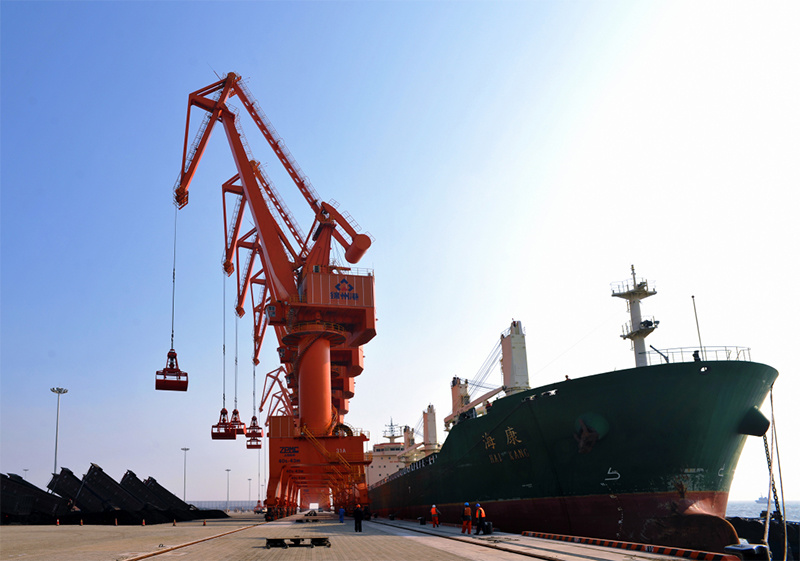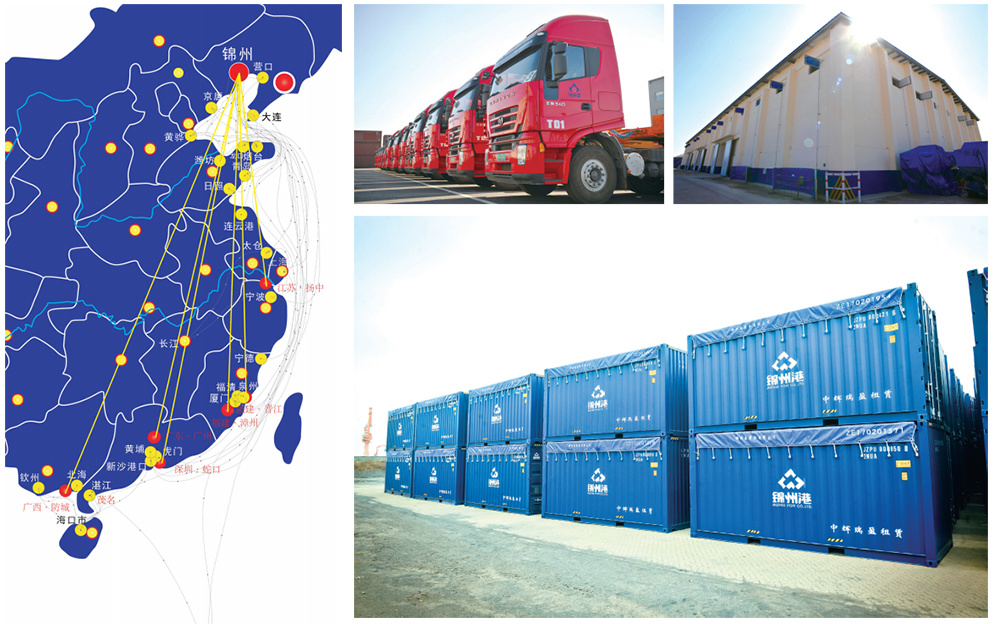Facility

|Dock berths
There are 27 berths. Including 1 300,000-ton oil berth, 5 100,000-ton bulk cargo berths, and 4 100,000-ton container berths. At present, the port can accommodate up to 250,000-ton oil tankers (load shedding) and 100,000-ton bulk cargo ships.
|Waterway anchorage
The total length of the main channel is 31 kilometers, the bottom width is 320 meters, and the water depth of the channel is -17.9 meters, which can meet the one-way navigation of 250,000-ton oil tankers and the two-way navigation of 50,000-ton and below ships. There are three anchorages in Jinzhou Port, with a water depth of -11 to -20 meters and an area of 32.31 million square meters. Port pilotage now utilizes a GPS system to allow round-the-clock de-berthing operations. The port is currently undergoing the expansion of the third anchorage and the construction of the fourth anchorage.
|Warehouse yards
The total area is 3,397,700 square meters, including 2,216,300 square meters of general cargo yard, 902,000 square meters of container yard, 155,000 square meters of silos, 124,400 square meters of room-type silos, steel silos and other yards; in addition, 150,000 tons of silos, 150,000 tons of room-type silos, 200,000 tons of general canopy projects are under construction; Jinzhou Port Bonded Logistics Center (Type B) is actively being declared.
Jinzhou Port signed an agreement with 18 foreign warehouse enterprises within 3 kilometers around the port, with high integrity, superior storage conditions, good service quality and high production efficiency, with an agreed warehouse capacity of 1.3 million tons.
In addition, Jinzhou Port has successfully approved 4 futures agreement warehouses with a total capacity of 360,000 tons, 6 futures extension warehouses with a total capacity of 1.13 million tons, and a futures delivery warehouse capacity of 250,000 tons in the port.
|Oil storage tanks
There are 141 storage tanks of various types in the port, with a total reserve of 3,548,240 cubic meters, of which 12 crude oil storage tanks are owned by our port with a reserve of 1.2 million cubic meters, and 6 storage tanks are under construction with a total reserve of 600,000 cubic meters. The total tank capacity of the port area is 4,148,240 cubic meters.

|Port Area Railway
The total length of railway lines in the port area is 39 kilometers, and the West Ring Line is connected with the Sangangchi Railway Line, and forms a ring line with the original railway lines and Gaotian Railway lines in the port area. There are a total of 33 loading and unloading truck lines in the port area, with a comprehensive capacity of 60 million tons per year. Among them, there are 4 coal lines, 13 miscellaneous lines (corn, silica sand, steel, petroleum coke, fertilizer, etc.), 13 oil lines, and 3 container lines.
|Operating vessels
The company has 6 full-swing tugboats in port, including 3 with 4,900 horsepower, 2 with 3,700 horsepower and 1 with 2,000 horsepower, with a total of 24,100 horsepower, which can provide services such as tuging, marine traffic and maritime rescue for ships entering and leaving the port.
|Machinery and equipment
Port production operations have been mechanized and specialized. Among them, 43,300 self-made containers have been successfully leased to liner companies such as Shanghai Hede, China Grain Shipping, and Antong Logistics, and 3,000 self-made open-top containers have enhanced the port's radiation power to long-distance grain sources.
|Construction of logistics system
Jinzhou Port has transformed from a single port handling provider to a logistics all-factor service provider. The service types are diverse, and the service chain extends from the "first kilometer" of the production area to the "last kilometer" of the sales area.
The logistics and distribution system is relatively complete. With road, railway, container, bulk ship and other means of transportation, it can combine the multimodal transportation modes such as road and railway, molten iron, road water, and distribution and mutual modification required by users.
Provide personalized logistics solutions for different types of goods. Relying on the advantages of port capital and scale, we will improve the professional logistics level of users by investing in special transportation tools for enterprises and joint venture and cooperation railway lines.





